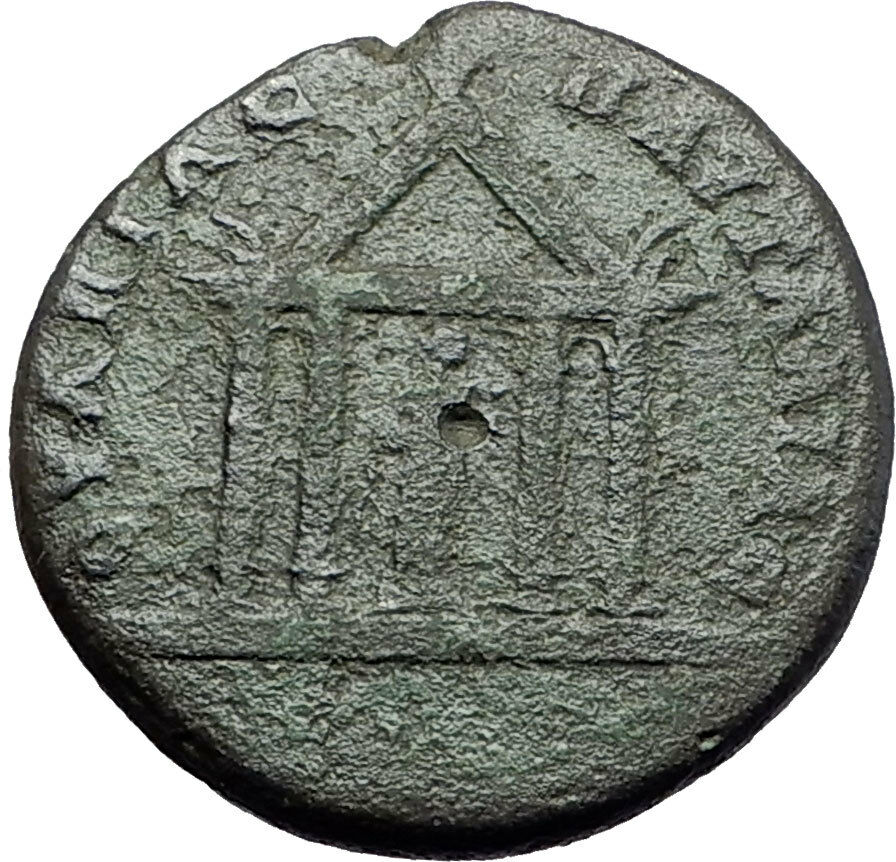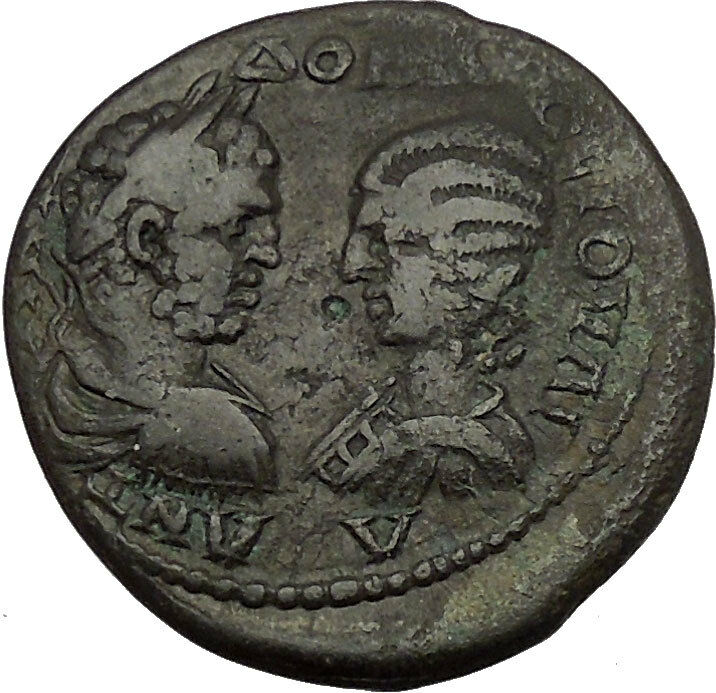|
Septimius Severus
–
Roman Emperor
: 193-211 A.D. –
Bronze 15mm (3.00 grams) of
Pautalia
in
Thrace
Laureate head right.
OVΛΠIAC ΠAVTAΛIAC,
Serpent entwined around central leg of tripod.
You are bidding on the exact
item pictured, provided with a Certificate of Authenticity and Lifetime
Guarantee of Authenticity.
A sacrificial tripod is a three-legged piece of religious furniture
used for offerings or other ritual procedures. As a seat or stand, the
tripod
is the most stable furniture
construction for uneven ground, hence its use is universal and ancient. It is
particularly associated with
Apollo
and the
Delphic oracle
in
ancient Greece
, and the word “tripod” comes
from the Greek meaning “three-footed.”

Apollo and
Heracles
struggle for the Delphic
tripod (Attic
black-figure
hydria
, c. 520 BC)
Ancient Greece
The most famous tripod of ancient Greece was the
Delphic
tripod from which the
Pythian priestess
took her seat to deliver the
oracles
of the deity. The seat was formed by a
circular slab on the top of the tripod, on which a branch of
laurel
was deposited when it was unoccupied by
the priestess. In this sense, by Classical times the tripod was sacred to
Apollo
. The
mytheme
of
Heracles
contesting with Apollo for the tripod
appears in vase-paintings older than the oldest written literature. The oracle
originally may have been related to the primal deity, the Earth.
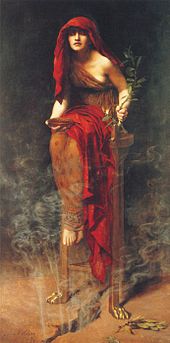
Priestess of Delphi (1891), as imagined by
John Collier
; the Pythia is
inspired by
pneuma
rising from below as she
sits on a tripod
Another well-known tripod in Delphi was the
Plataean Tripod
; it was made from a tenth part
of the spoils taken from the
Persian
army after the
Battle of Plataea
. This consisted of a golden
basin, supported by a
bronze
serpent
with three heads (or three serpents
intertwined), with a list of the states that had taken part in the war inscribed
on the coils of the serpent. The golden bowl was carried off by the
Phocians
during the
Third Sacred War
(356–346 BC); the stand was
removed by the emperor
Constantine
to
Constantinople
in 324, where in modern
Istanbul
it still can be seen in the
hippodrome
, the Atmeydanı, although in
damaged condition: the heads of the serpents have disappeared, however one is
now on display at the nearby Istanbul Archaeology Museums. The inscription,
however, has been restored almost entirely. Such tripods usually had three
ears (rings which served as handles) and frequently had a central upright as
support in addition to the three legs.
Tripods frequently are mentioned by
Homer
as prizes in
athletic games
and as complimentary gifts; in
later times, highly decorated and bearing inscriptions, they served the same
purpose. They also were used as dedicatory
offerings
to the deities, and in the dramatic
contests at the Dionysia
the victorious
choregus
(a wealthy citizen who bore the
expense of equipping and training the chorus) received a crown and a tripod. He
would either dedicate the tripod to some deity or set it upon the top of a
marble structure erected in the form of a small circular temple in a street in
Athens
, called the street of tripods,
from the large number of memorials of this kind. One of these, the
Choragic Monument of Lysicrates
, erected by him
to commemorate his victory in a dramatic contest in 335 BC, still stands. The
form of the victory tripod, now missing from the top of the Lysicrates monument,
has been rendered variously by scholars since the 18th century.
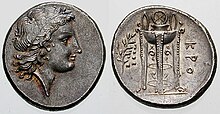
An ancient Greek coin c. 330-300 BC. Laureate head of Apollo (left)
and ornate tripod (right).
Martin L. West
writes that the sibyl at Delphi
shows many traits of
shamanistic
practices, likely inherited or
influenced from Central Asian practices. He cites her sitting in a cauldron on a
tripod, while making her prophecies, her being in an ecstatic trance state,
similar to shamans, and her utterings, unintelligible.
According to Herodotus (The Histories, I.144), the victory tripods were not
to be taken from the temple sanctuary precinct, but left there as dedications.
Sometimes the tripod was used as a support for a
lebes
or cauldron or for supporting other items
such as a vase.
-
Delphic tripod (red-figured
bell-krater
,
Paestum
, c. 330 BC)
Ancient China
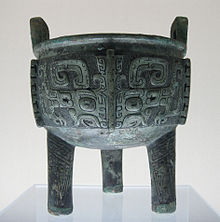
A
ding
from the late
Shang Dynasty
.
Tripod pottery have been part of the archaeological assemblage in China since
the earliest Neolithic cultures of
Cishan
and
Peiligang
in the 7th and 8th millennium BC.
Sacrificial tripods were also found in use in ancient
China
usually cast in bronze but sometimes
appearing in ceramic form. They are often referred to as “dings”
and usually have three legs, but in some usages have four legs.
The Chinese use sacrificial tripods in modern times, such as in 2005, when a
“National Unity Tripod” made of bronze was presented by the central Chinese
government to the government of northwest China’s
Xinjiang Uygur Autonomous Region
to mark its
fiftieth birthday. It was described as a traditional Chinese sacrificial vessel
symbolizing unity.

Serpents
and snakes play a role in many of the world’s myths and legends. Sometimes these
mythic beasts appear as ordinary snakes. At other times, they take on magical or
monstrous forms. Serpents and snakes have long been associated with good as well
as with evil, representing both life and death, creation and destruction.
Serpents and Snakes as Symbols. In religion, mythology, and
literature, serpents and snakes often stand for fertility or a creative life
force—partly because the creatures can be seen as symbols of the male sex organ.
They have also been associated with water and earth because many kinds of snakes
live in the water or in holes in the ground. The ancient Chinese connected
serpents with life-giving rain. Traditional beliefs in Australia, India, North
America, and Africa have linked snakes with rainbows, which in turn are often
related to rain and fertility.
As snakes grow, many of them shed their skin at various times, revealing a
shiny new skin underneath. For this reason snakes have become symbols of
rebirth, transformation, immortality, and healing. The ancient Greeks
considered snakes sacred to Asclepius, the god of medicine. He carried a
caduceus, a staff with one or two serpents wrapped around it, which has become
the symbol of modern physicians.
For both the Greeks and the Egyptians, the snake represented eternity.
Ouroboros, the Greek symbol of eternity, consisted of a snake curled into a
circle or hoop, biting its own tail. The Ouroboros grew out of the belief that
serpents eat themselves and are reborn from themselves in an endless cycle of
destruction and creation.
Serpents figured prominently in archaic Greek myths. According to some
sources,
Ophion (“serpent”, a.k.a. Ophioneus), ruled the world with Eurynome
before the two of them were cast down by Cronus and Rhea. The oracles of the
Ancient Greeks were said to have been the continuation of the tradition begun
with the worship of the Egyptian cobra goddess,
Wadjet.
The
Minoan
Snake
Goddess brandished a serpent in either hand, perhaps evoking her role
as source of wisdom, rather than her role as Mistress of the Animals (Potnia
theron), with a leopard
under each arm. She is a Minoan version
of the Canaanite
fertility goddess
Asherah.
It is not by accident that later the infant
Heracles,
a liminal hero on the threshold between the old ways and the new Olympian world,
also brandished the two serpents that “threatened” him in his cradle. Classical
Greeks did not perceive that the threat was merely the threat of wisdom. But the
gesture is the same as that of the Cretan goddess.
Typhon
the enemy of the Olympian gods is described as a vast grisly monster with a
hundred heads and a hundred serpents issuing from his thighs, who was conquered
and cast into Tartarus
by
Zeus,
or confined beneath volcanic regions, where he is the cause of eruptions. Typhon
is thus the chthonic figuration of volcanic forces. Amongst his children by
Echidna are Cerberus
(a monstrous three-headed dog with a
snake for a tail and a serpentine mane), the serpent tailed
Chimaera
, the serpent-like chthonic water beast
Lernaean Hydra and the hundred-headed serpentine dragon
Ladon.
Both the Lernaean Hydra and Ladon were slain by
Heracles.
Python
was the earth-dragon of
Delphi,
she always was represented in the vase-paintings and by sculptors as a serpent.
Pytho was the chthonic enemy of Apollo
, who slew her and remade her former home
his own oracle, the most famous in Classical Greece.
Amphisbaena a Greek word, from amphis, meaning “both ways”, and
bainein, meaning “to go”, also called the “Mother of Ants”, is a mythological,
ant-eating serpent with a head at each end. According to Greek mythology, the
mythological amphisbaena was spawned from the blood that dripped from
Medusa
the Gorgon‘s
head as
Perseus flew over the Libyan Desert with her head in his hand.
Medusa and the other Gorgons were vicious female monsters with sharp fangs
and hair of living, venomous snakes whose origins predate the written myths of
Greece and who were the protectors of the most ancient ritual secrets. The
Gorgons wore a belt of two intertwined serpents in the same configuration of the
caduceus.
The Gorgon was placed at the highest point and central of the relief on the
Parthenon.
Asclepius, the son of Apollo and Koronis, learned the secrets of
keeping death at bay after observing one serpent bringing another (which
Asclepius himself had fatally wounded) healing herbs. To prevent the entire
human race from becoming immortal under Asclepius’s care, Zeus killed him with a
bolt of lightning. Asclepius’ death at the hands of Zeus illustrates man’s
inability to challenge the natural order that separates mortal men from the
gods. In honor of Asclepius, snakes were often used in healing rituals.
Non-poisonous snakes were left to crawl on the floor in dormitories where the
sick and injured slept. In
The Library
,
Apollodorus claimed that
Athena
gave Asclepius a vial of blood from the Gorgons. Gorgon blood had magical
properties: if taken from the left side of the Gorgon, it was a fatal poison;
from the right side, the blood was capable of bringing the dead back to life.
However
Euripides wrote in his tragedy
Ion
that the Athenian queen Creusa had
inherited this vial from her ancestor Erichthonios, who was a snake himself and
receiving the vial from Athena. In this version the blood of Medusa had the
healing power while the lethal poison originated from Medusa’s serpents.
Laocoön
was allegedly a priest of Poseidon
(or of Apollo, by some accounts) at
Troy;
he was famous for warning the Trojans in vain against accepting the Trojan Horse
from the Greeks, and for his subsequent divine execution. Poseidon (some say
Athena),
who was supporting the Greeks, subsequently sent sea-serpents to strangle
Laocoön and his two sons, Antiphantes and Thymbraeus. Another tradition states
that Apollo sent the serpents for an unrelated offense, and only unlucky timing
caused the Trojans to misinterpret them as punishment for striking the Horse.
Olympias, the mother of
Alexander the Great
and a princess of the
primitive land of
Epirus
, had the reputation of a snake-handler,
and it was in serpent form that Zeus was said to have fathered Alexander upon
her; tame snakes were still to be found at Macedonian
Pella
in the 2nd century AD (Lucian,
Alexander the false prophet
) and at
Ostia
a bas-relief shows paired coiled serpents
flanking a dressed altar, symbols or embodiments of the
Lares
of the household, worthy of veneration (Veyne 1987 illus p 211).
Aeetes
, the king of
Colchis
and father of the sorceress Medea
, possessed the
Golden Fleece. He guarded it with a massive serpent that never slept.
Medea, who had fallen in love with Jason
of the
Argonauts,
enchanted it to sleep so Jason could seize the Fleece.
Kyustendil (Bulgarian:
Кюстендил, historically
Велбъжд, Velbazhd) is a town in the
far west of Bulgaria
, the capital of
Kyustendil Province
, with a population of
58,059 (2005 census). Kyustendil is situated in the southern part of the
Kyustendil Valley, 90 km southwest of
Sofia
. It was named after the medieval lord of
the surrounding region,
Constantine Dragaš
.
A Thracian
settlement was founded at the place of
the modern town in the
5th
-4th century BC and the
Romans
developed it into an important
stronghold, balneological resort and trade junction called Pautalia
in the 1st century AD.
The Hisarlaka fortress was built in the 4th century and the town was
mentioned under the
Slavic
name of Velbazhd (Велбъжд,
meaning “camel”)[1]
in a 1019 charter by the
Byzantine
Emperor
Basil II
. It became a major religious and
administrative centre.
L ucius Septimius Severus (or rarely Severus I) (April 11, ucius Septimius Severus (or rarely Severus I) (April 11,
145/146-February 4, 211) was a
Roman
general, and
Roman
Emperor
from April 14, 193 to 211. He was born in what is now the
Berber
part of
Rome’s historic
Africa Province
.
Septimius Severus was born and raised at
Leptis
Magna
(modern Berber
, southeast of
Carthage
,
modern Tunisia
).
Severus came from a wealthy, distinguished family of
equestrian
rank. Severus was of
Italian
Roman ancestry on his mother’s side and of
Punic
or
Libyan
-Punic
ancestry on his father’s. Little is known of his father,
Publius Septimius Geta
, who held no major political status but had two
cousins who served as consuls under emperor
Antoninus Pius
. His mother, Fulvia Pia’s family moved from
Italy
to
North
Africa
and was of the
Fulvius
gens,
an ancient and politically influential clan, which was originally of
plebeian
status. His siblings were a younger
Publius Septimius Geta
and Septimia Octavilla. Severus’s maternal cousin was
Praetorian Guard
and consul
Gaius Fulvius Plautianus
.
In 172, Severus was made a
Senator
by the then emperor
Marcus Aurelius
. In 187 he married secondly
Julia
Domna
. In 190 Severus became
consul
, and in
the following year received from the emperor
Commodus
(successor to Marcus Aurelius) the command of the
legions
in Pannonia
.
On the murder of
Pertinax
by
the troops in 193, they proclaimed Severus Emperor at
Carnuntum
,
whereupon he hurried to Italy. The former emperor,
Didius Julianus
, was condemned to death by the Senate and killed, and
Severus took possession of Rome without opposition.
The legions of
Syria
, however, had proclaimed
Pescennius Niger
emperor. At the same time, Severus felt it was reasonable
to offer
Clodius Albinus
, the powerful governor of Britannia who had probably
supported Didius against him, the rank of Caesar, which implied some claim to
succession. With his rearguard safe, he moved to the East and crushed Niger’s
forces at the
Battle of Issus
. The following year was devoted to suppressing Mesopotamia
and other Parthian vassals who had backed Niger. When afterwards Severus
declared openly his son
Caracalla
as successor, Albinus was hailed emperor by his troops and moved to Gallia.
Severus, after a short stay in Rome, moved northwards to meet him. On
February
19
, 197
,
in the
Battle of Lugdunum
, with an army of 100,000 men, mostly composed of
Illyrian
,
Moesian
and
Dacian
legions,
Severus defeated and killed Clodius Albinus, securing his full control over the
Empire.
Emperor
Severus was at heart a
soldier
, and
sought glory through military exploits. In 197 he waged a brief and successful
war against the
Parthian Empire
in retaliation for the support given to Pescennius Niger.
The Parthian capital
Ctesiphon
was sacked by the legions, and the northern half of
Mesopotamia
was restored to Rome.
His relations with the
Roman
Senate
were never good. He was unpopular with them from the outset, having
seized power with the help of the military, and he returned the sentiment.
Severus ordered the execution of dozens of Senators on charges of corruption and
conspiracy
against him, replacing them with his own favorites.
He also disbanded the
Praetorian Guard
and replaced it with one of his own, made up of 50,000
loyal soldiers mainly camped at
Albanum
, near Rome (also probably to grant the emperor a kind of centralized
reserve). During his reign the number of legions was also increased from 25/30
to 33. He also increased the number of auxiliary corps (numerii), many of
these troops coming from the Eastern borders. Additionally the annual wage for a
soldier was raised from 300 to 500
denarii
.
Although his actions turned Rome into a military
dictatorship
, he was popular with the citizens of Rome, having stamped out
the rampant corruption of Commodus’s reign. When he returned from his victory
over the Parthians, he erected the
Arch of Septimius Severus
in Rome.
According to Cassius Dio,
however, after 197 Severus fell heavily under the influence of his Praetorian
Prefect,
Gaius Fulvius Plautianus
, who came to have almost total control of most
branches of the imperial administration. Plautianus’s daughter,
Fulvia Plautilla
, was married to Severus’s son, Caracalla. Plautianus’s
excessive power came to an end in 205, when he was denounced by the Emperor’s
dying brother and killed.
The two following praefecti, including the jurist
Aemilius Papinianus
, received however even larger powers.
Campaigns in Caledonia (Scotland)
Starting from 208 Severus undertook a number of military actions in
Roman
Britain
, reconstructing
Hadrian’s Wall
and campaigning in
Scotland
.
He reached the area of the
Moray
Firth
in his last campaign in Caledonia, as was called Scotland by
the Romans..
In 210 obtained a peace with the
Picts
that lasted
practically until the final withdrawal of the Roman legions from Britain,
before falling severely ill in
Eboracum
(York).
Death
He is famously said to have given the advice to his sons: “Be harmonious,
enrich the soldiers, and scorn all other men” before he died at Eboracum on
February 4
,
211. Upon his death in 211, Severus was
deified
by the Senate and succeeded by his sons,
Caracalla
and
Geta
, who were advised by his wife
Julia
Domna
. The stability Severus provided the Empire was soon gone under their reign.
Accomplishments and Record
Though his military expenditure was costly to the empire, Severus was the
strong, able ruler that Rome needed at the time. He began a tradition of
effective emperors elevated solely by the military. His policy of an expanded
and better-rewarded army was criticized by his contemporary
Dio Cassius
and
Herodianus
: in particular, they pointed out the increasing burden (in the
form of taxes and services) the civilian population had to bear to maintain the
new army.
Severus was also distinguished for his buildings. Apart from the triumphal
arch in the Roman Forum carrying his full name, he also built the
Septizodium
in Rome and enriched greatly his native city of
Leptis
Magna
(including another triumphal arch on the occasion of his visit of
203).
Severus and Christianity
Christians were
persecuted
during the reign of Septimus Severus. Severus allowed the
enforcement of policies already long-established, which meant that Roman
authorities did not intentionally seek out Christians, but when people were
accused of being Christians they could either curse
Jesus
and make an
offering to
Roman gods
, or be executed. Furthermore, wishing to strengthen the peace by
encouraging religious harmony through
syncretism
,
Severus tried to limit the spread of the two quarrelsome groups who refused to
yield to syncretism by outlawing
conversion
to Christianity or
Judaism
.
Individual officials availed themselves of the laws to proceed with rigor
against the Christians. Naturally the emperor, with his strict conception of
law, did not hinder such partial persecution, which took place in
Egypt
and the
Thebaid
, as
well as in
Africa proconsularis
and the East. Christian
martyrs
were
numerous in Alexandria
(cf.
Clement of Alexandria
, Stromata, ii. 20;
Eusebius
, Church History, V., xxvi., VI., i.). No less severe were
the persecutions in Africa, which seem to have begun in 197 or 198 (cf.
Tertullian’s
Ad martyres), and included the Christians known in the
Roman martyrology
as the martyrs of
Madaura
.
Probably in 202 or 203
Felicitas
and
Perpetua
suffered for their faith. Persecution again raged for a short time
under the proconsul
Scapula
in
211, especially in
Numidia
and
Mauritania
.
Later accounts of a Gallic
persecution, especially at
Lyon, are
legendary. In general it may thus be said that the position of the Christians
under Septimius Severus was the same as under the
Antonines
;
but the law of this Emperor at least shows clearly that the
rescript
of
Trajan
[clarification
needed] had failed to execute its purpose.
|











 ucius Septimius Severus (or rarely Severus I) (April 11,
ucius Septimius Severus (or rarely Severus I) (April 11, 